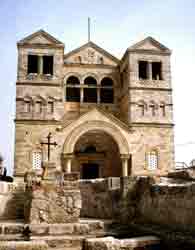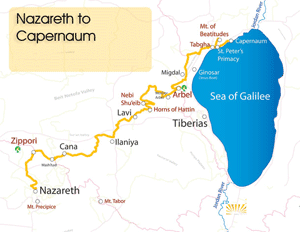Nazareth & Surroundings
 |
NazarethNazareth is the largest Arab city in Israel, with a population of 60,000, once split nearly evenly between Christians and Muslims, but now nearly two-thirds Muslim. The two groups have lived harmoniously, though a dispute erupted in 1999 over the desire of Muslims to build a mosque near a church. Nazareth was apparently never an important site in Jewish history; it is not mentioned in the Old Testament or rabbinic literature, though Jews certainly lived there in Jesus' time. The first reference is in the New Testament (John 1:45) and, even there, the town is referred to in a negative way ("Can there any good thing come out of Nazareth?" 1:46) For Christians, Nazareth is important because it is the place where Jesus spent much of his life. The Church of St. Joseph's Carpentry contains ruins dating to the 1st century, and is revered as the original workshop of Joseph and home of the Holy Family. The site actually was abandoned for many years until Franciscans bought it in 1754 and set up a chapel dedicated to Joseph. The church there today was built above the ruins of a 13th century Crusader church.
Nazareth also has several other important churches, the Synagogue-Church, where Jesus preached (Luke 4), Gabriel's Church, which Greek Catholics believe to be the site of the Annunciation and the Mensa Christi ("Table of Christ") Church, where Jesus is said to have dined with his Apostles after his Resurrection. The Basilica of the Annunciation is the place where, according to Christian tradition, the angel Gabriel appeared before Mary, saying: "Behold, thou shalt conceive in thy womb, and bring forth a son, and shall call his name Jesus" (Luke 1:26-35). The Church, the largest house of Christian worship in the Middle East, has been controlled by the Muslims since Saladin's conquest in 1198. When the Ottoman Turks captured the city in the 16th century, they expelled all the Christians. They were not allowed to return until the reign of the Emir of Lebanon, Fakhr ad-Din II (1590-1635). The present building took nearly a decade to build before being completed in 1969 over the remains of earlier structures dating to the Byzantine period. The Greek Orthodox have their own Church of the Annunciation where they believe Gabriel appeared to Mary. This church was built nearly three centuries ago over the well where Mary is said to have drawn water. When Jesus left Nazareth, he performed his first miracle, changing water into wine at Cana (John 2:11, 4:46), now the Arab village of Kafr Kana, ten minutes up the Tiberias road. The Muslims have built seven mosques in Nazareth, the largest, the Peace Mosque, was built in 1963. The el-Abyad Mosque, to the north of the Basilica of the Annunciation, was built in 1812, and is the oldest in the city. A dispute arose when Muslims in Nazareth proposed building a mosque next to the Basilica of the Annunciation in 1997. Initially, the Israeli government agreed to allow construction, but the decision was protested by Christian leaders. Ironically, Jews essentially became referees in a five-year religious tug-of-war between Muslims and Christians. In the end, a government committee announced in 2002 that the mosque should not be built. Jews have also begun to settle in the city. Nazareth Illit (Upper Nazareth) is a relatively new town that has become a popular home for new immigrants from the former Soviet Union. Mt. Tabor
About six miles southeast of Nazareth stands Mt. Tabor, a dome-shaped mountain rising nearly 2,000 feet above the Jezreel Valley. From the camp at Mt. Tabor around 1150 B.C.E., Deborah and Barak led the armies of Israel in the battle agains Sisera, the Canaanite general (Judges 4:12-16). This was also the site of a thriving Jewish community which constructed a fort there during the Second Temple period. The mountain is holy to Christians who believe it is the site of the Transfiguration of Jesus (Luke 9:28-36). During the Byzantine and Crusader eras, several monasteries were build on the mountain, which were subseqently destroyed by Arab conquerors. The Basilica of the Transfiguration was built in the 1920s over the ruins of older churches. The Greek Orthodox Church of Elias is also on the summit. The sometimes windswept peak affords a spectacular view of the valley and, on a clear day, it is possible to see the Mediterranean, the Sea of Galilee and Mount Hermon. The Gospel TrailThe Gospel, or Jesus, Trail offers pilgrims and tourists, individuals and groups, the opportunity to discover the cradle of Christianity by experiencing – both physically and spiritually – the same biblical landscapes and sites of the Galilee where Jesus and his disciples once walked. The Gospel Trail incorporates over 60 kilometers (40 miles) of specially-signposted footpaths and roads which can be traveled on foot, by bicycle and/or car, culminating in the spiritual highlight of sailing on the Sea of Galilee.
The modular trail, which became fully open to the public in November 2011, follows historical routes and paths that Jesus is believed to have taken when he left Nazareth, the home of his childhood, for Capernaum on the northwestern shore of the Sea of Galilee, which became the center of his ministry. Luke 4: 29 -31: “And they led him to the brow of the hill on which their city was built, that they might throw Him down over the cliff. Then passing through the midst of them, he went his way. Then he went down to Capernaum, a city of Galilee…” The main section of the trail, which begins at Mount Precipice, includes Jezreel Valley, Beit Qeshet Oak Reserve, along the Arbel Mountain through Magdala, Tabgha and Capernaum. Secondary routes of the Gospel Trail will take visitors to Mount Tabor and the Church of the Transfiguration, Kafr Kanna, the Horns of Hitim, Mount Arbel, and the Mount of Beatitudes. All of these routes will end at the main destination at the Capernaum center, where Gospel Trail walkers will be able to continue their spiritual journey on the Sea of Galilee itself. A special dock has been constructed, and there will be areas for prayer and inspirational solitude on the shoreline. The Israel Tourism Ministry in cooperation with KKL-JNF invested more than $700,000 in the Gospel Trail's infrastructure. This includes unique signage hewn into basalt rocks that blend into the natural landscape and feature the relevant scripture readings for the site, safety barriers, shaded rest areas, stone benches, picnic sites and tourist information. |
| Previous | Next |






